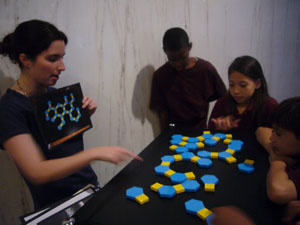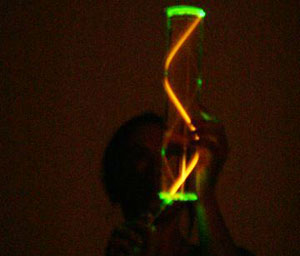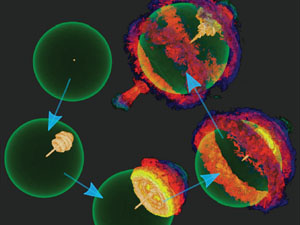Final Projects - MSCOPE '07-08
Through the year we formed groups of two to three interns from different disciplines to work on a particular project. Following are the accomplishments of the year 07-08.

Developing team: Melanie Hopkins, Margo Levine
Coaches: Brenda Lopez, Panos Oikonomou
In this demonstration we introduce MSI's audience to self-assembly, how we can use
molecules that attract or repulse each other to
design objects too small for traditional manufacturing. This process, called self-assembly, is demonstrated using several interactive activities,
including magnetized pieces of wood moving around on an air table and magnetized strings of beads lining up in rows. Interspersed with the activities are
explanations of the nano-scale and of applications in cancer treatment, a topic chosen in response to museum visitor interests. The goal of these hands-on
activities is to show how innovations are possible because of an increased understanding of how nano-scale particles
self-assemble. Nanotechnology is considered
by many to be the future of scientific research, affecting industries ranging from engineering and computer science to molecular biology and medicine.
more...
![]() Nano-vations!: Report
Nano-vations!: Report

Developing team: Alison Brizius, Margo Levine, Thomaie Hilaris
Coach: Panos Oikonomou, Brenda Lopez
Light Benders invites MSI visitors to experience how light travels. Light can bend and bounce and take unexpected paths! Through
a series of small activities with laser beams we explain how light moves inside different materials and how that affects the way we see everything around us.
Vistors make objects dissapear and understand how optical fibers work.
more...
![]() Light Benders: Report
Light Benders: Report

Developing team: Nathan Hearn, Sarah Kautz, Brad Gallagher, Nathan Keim
Coach: Panos Oikonomou and Brenda Lopez
Cracking the mystery is a current science show. We invite visitors of the Adler Planetarium to meet a scientist from the
FLASH center at the University of Chicago and explore together how stars explode.
These explosions called supernovae are very distant objects -- appearing as just a dot on the sky. We normally only
observe them after the explosion occurred and we can't really see the details using our telescopes. To get more information we have to do something different. At
the FLASH center, we build models of stars on a computer. These models produce fascinating graphics and tell us much about how a supernova occurs.
more...
![]() Supernova: Report
Supernova: Report





